Electric cars can't reach Shanhaiguan, because 600 kilometers can't withstand the bitter winter. You dare not turn on warm air in winter and cold air in summer. This is all because of the damn virtual standard of electric vehicles. You don't know how far the remaining 100km power can last. On the other side, there are various fancy life marketing of car enterprises: how much to convert the life under wltp and CLTC conditions that you can't understand, how much credibility to challenge minus 30 degrees for low-temperature life, what is the capitalized wind resistance coefficient and how to choose a car. Users are also very messy.
New energy vehicles have entered the Chinese market for more than ten years, but the anxiety about the endurance of users has not stopped. In fact, these anxieties are not because the battery life of electric vehicles really can not meet the needs of users, but users can't see the battery life of fresh cars. Just like instant noodles in advertisements, what you eat is never the same as that on TV.
About the correct opening method of endurance standard
When you open Weilai app, the new car et5 shows CLTC endurance and es8 shows NEDC endurance. Nowadays, many new cars on the market, such as the newly launched Zero run C01, directly publicize the CLCT's endurance of 717km.
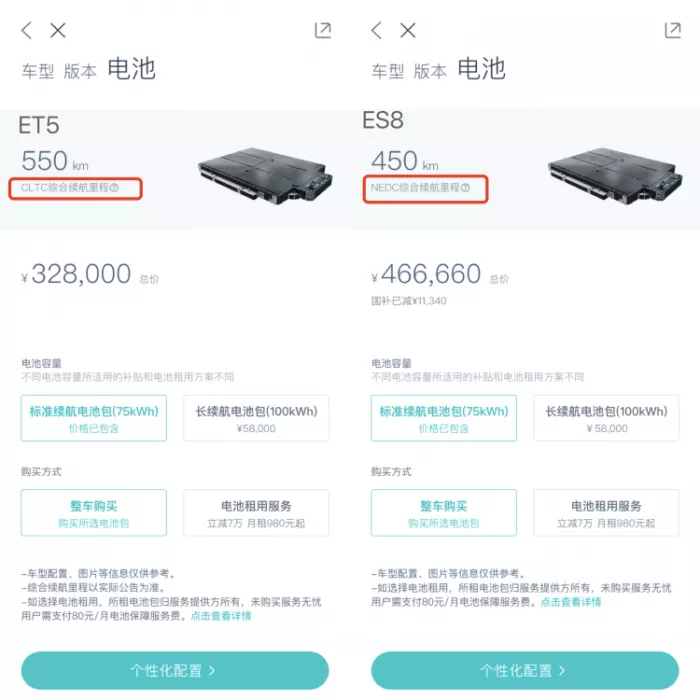
Picture source of endurance standard displayed by et5 and es8 on Weilai app: Weilai app
Now, after OTA of many models, only NEDC endurance is displayed on the instrument panel, which has become wltp endurance.
Why does the new car endurance publicity change from NEDC to CLTC, and there are NEDC and wltp on the instrument panel?
If you look around the Internet, there are various standards for the endurance of new cars, and these are all common names for users:
Not true endurance
The new car's endurance includes CLTC mode and NEDC mode. The wltp mode is used in the test. Which is closer to the true endurance?
Before July 2021, NEDC was still the standard for evaluating the range of electric vehicles in China. With the update of the mandatory national standard (gb19578-2021) of fuel consumption limits for passenger cars formulated by the Ministry of industry and information technology, wltc replaced NEDC.
Wltc is the global light vehicle test cycle, and NEDC is the new standard European test cycle.
NEDC has always been the standard for motor vehicle fuel consumption and electric vehicle range in China. Compared with wltc, the test scenario of NEDC is more ideal.
For example, the test environment of NEDC is to put the electric vehicle on the test bench, turn off the energy consumption configuration such as air conditioning, headlights and sound, simulate four urban working conditions and one suburban working condition for test, and set the temperature at 20 ℃ ~ 30 ℃.
This test environment is almost divorced from our daily vehicle environment. The temperature is appropriate, without air conditioning or music, not to mention the impact on battery energy consumption in high or low temperature environment. Therefore, it is not surprising that an electric vehicle with a NEDC endurance of 500km actually drives at the level of 350km.
In comparison, the test environment of wltc is closer to the daily use environment of car owners. For example, in the simulated working conditions, it includes four different working conditions: urban (low speed), suburban (medium speed), rural (high speed) and expressway (ultra-high speed). The corresponding maximum speeds are 56.5km/h, 76.6km/h, 97.4km/h and 131.3km/h respectively. The corresponding single cycle time is longer, and different operations such as parking, braking and rapid acceleration are set.
At the same time, compared with the fixed gear of NEDC, wltp adopts the gear change of non fixed mode, and changes different drivers to simulate the real situation. External temperature, vehicle quality, gear status, rolling resistance, load, acceleration and deceleration and other factors are included in the assessment system.
In addition to NEDC and wltp, two working condition standards related to the change of evaluation standards, in fact, in China, China Automotive Research Institute also designed CLTC working condition, that is, China Light Vehicle test cycle, and made some improvements on some test conditions for China's road conditions. For example, the speed limit of Expressway in China is 120 km / h, and CLTC will be lower than NEDC and wltp in test speed limit.
From the severity index of the test, CLTC & gt; WLTP > NEDC, of course, is also relative.
CLTC can be seen from its name that it is a standard that adapts measures to local conditions. The notice on matters related to double point accounting in 2021 previously issued by the Ministry of industry and information technology said that in terms of pure electric passenger vehicles, manufacturers can choose NEDC working condition or CLTC working condition to determine electric energy consumption and pure electric driving mileage. Therefore, since last October, many new cars have switched to CLTC mode.
However, many users find that after switching to the new endurance standard, the endurance of the same car seems to be longer.
The NEDC endurance of model 3 was originally marked as 605km, but it became 675km after reaching CLTC. The designer, China Automotive Research Institute, explained that this is because CLTC is testing frequent acceleration and deceleration, which is in line with the actual domestic stop and go situation. More frequent acceleration and deceleration conditions are very conducive to improving the endurance of electric vehicles with kinetic energy recovery and higher efficiency.
This increase in endurance may represent a technological progress, but for users, it is actually confused.
There is also a simple judgment method. If you choose a new car, the one with the highest CLTC and wltp is preferred.
However, this is only a theoretical reference about real endurance. If combined with the actual situation, it will be much more complicated. After all, no matter what car it is, the test content under the same standard is the same. But in fact, each car has its own unique driving characteristics and driving environment, and many factors are outside the standard.
In the view of users, whether NEDC, wltc or CLTC, the official endurance standards of various caliber are actually higher than the real mileage of pure electric vehicles, which is also the fundamental reason for the endurance anxiety of new energy owners and potential owners.
What factors affect the endurance
Although various endurance standards provide a certain reference basis, many car owners ignore that the use of new energy vehicles is divided into different scenarios due to different cities and environments. The endurance performance of the same model is also different in different use environments.
Recently, chedi and general technology China automotive research launched the industry's first new energy vehicle owner endurance query function, with data covering models of dozens of popular new energy brands in 33 cities across the country.
These sample data are based on cities with high insurance volume, covering mainstream electric vehicles in the market, from A00 (micro), A0 (small) to C (medium and large). There are not only the popular Wuling Hongguang Mini EV, Tesla Model y and Tesla Model 3, as well as the models of BYD, Weilai and Xiaopeng, but also the Volkswagen ID. series and the electric models of BMW and Mercedes Benz.
Based on this, they also released a mileage analysis report, and we can see some interesting conclusions:
Temperature is the main factor affecting the reliability of actual range performance In May, the South and North regions were least affected by the temperature, and the reliability of the average range of vehicles reached the highest in the whole year.
In July, the country was generally hot, and the mileage credibility of northern cities performed better. Similarly, in the cold winter of January, the mileage credibility of Shenyang and Beijing was only 60%.
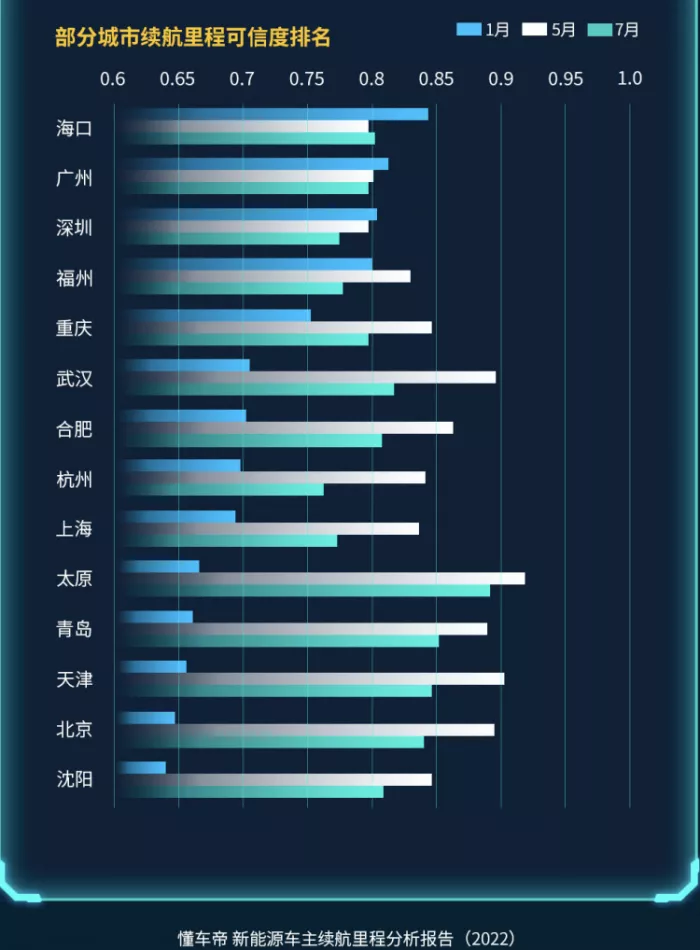
Figure source: understand chedi
In fact, the size of the model also has an impact on the endurance performance In the survey, chedi selected Beijing 1, 5 and 7 months to make a comparative analysis of 22 pure electric vehicle types. It was found that the endurance performance of A00 car was better, among which the reliability of Chery ant's endurance mileage in 1, 5 and 6 months reached 82%, 98.8% and 97.8% respectively. At the same time, the larger the model, the lower the reliability of mileage.
In other words, the greater the vehicle weight, the greater the rolling resistance and the higher the energy consumption of the whole vehicle, which will significantly affect the endurance.

Figure source: understand chedi
However, vehicle service life has little impact on the reliability of vehicle range** In the report, the report on the average actual mileage reliability of models in different mileage segments in Beijing in February 2022 will find that with the increase of mileage segments, the actual mileage of most sample vehicles has not declined, and the actual mileage reliability of models such as aions, BYD Han EV, geometry a and velai es8 has also increased.
This may violate our common sense of daily cognition. Many people will use mobile phones as an analogy. Generally speaking, after using our smart phones for a year or two, the standby time will be shorter and shorter.
On the one hand, the report shows the driving data within 60000 kilometers. Generally speaking, 60000 kilometers is not enough to make the power battery reach a high attenuation speed, which has little impact on daily use. On the other hand, this may also indicate that the battery attenuation speed is far less than the impact of different operating environments on battery life.
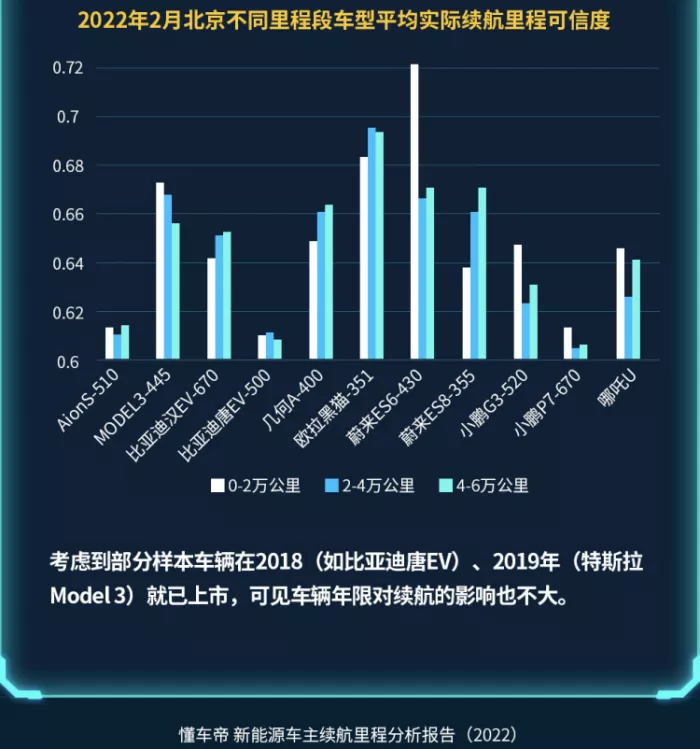
Figure source: understand chedi
In fact, the endurance results of the same model and different use environments are quite different.
It is also Xiaopeng P7. It is known that the last Hangzhou owner used NEDC with a range of 670km. When the air conditioner is turned on in winter, the real range tested is only 270km. A Chongqing Xiaopeng P7 owner used NEDC with a range of 480km. Under the driving environment of not turning on the air conditioner in winter and often climbing uphill, the range in winter was 310-330km.
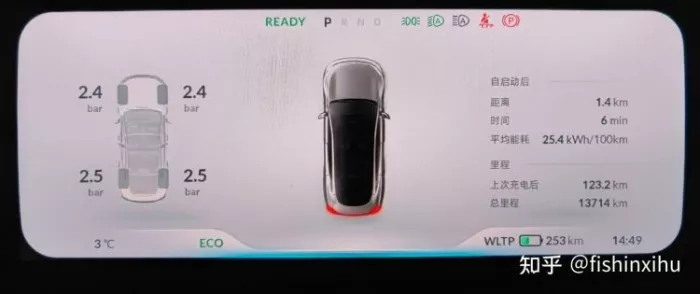
Zhihu winter endurance map released by Hangzhou Xiaopeng P7 owner source: Zhihu
Although both car owners use data in winter, due to different winter temperatures and terrain environments in different regions, as well as different driving habits we can't see, they may lead to different real endurance results.
In other words, there are many factors affecting the real endurance. The report mentioned temperature, terrain and vehicle use factors, such as mileage, driving habits, etc. At the same time, in the model dimension, in addition to the obvious kerb quality, as well as the body shape and other factors, all have a practical impact on the endurance.
Now many new cars will be exposed to the wind resistance coefficient, and more and more domestic and foreign automobile manufacturers have made great efforts in aerodynamics. The smaller the wind resistance coefficient, which means that when driving at high speed, the less work the vehicle does to resist the wind resistance, so as to reduce energy consumption and achieve longer mileage.
For example, at present, the Mercedes Benz EQS with the lowest wind resistance coefficient is only 0.20Cd. Many new cars in China, such as Weilai et7 and Zhiji L7, have relatively low wind resistance coefficient. The lower drag coefficient will make its endurance performance more prominent in the models of the same level.
How to become a rational electric vehicle owner
There are so many factors affecting the real endurance, how should we wring out the water?
As for the real endurance, there are actually some evaluations that help users screen the real endurance. The range of new energy car owners released by chedi in conjunction with China automotive research is this type.
On the model page of understanding chedi app, there will be real range data including the owner's range, measured in summer and measured in winter, of which the measured data are included in different range versions of each model.
Taking the official 506km endurance version of BYD Han EV as an example, it can be seen on the vehicle owner's endurance page that the data used by vehicle owners in March was 398km, and the endurance achievement rate was 78.66%. At the same time, it also includes the driving range data trend within 10000 kilometers. With the continuous updating of owner data, more mileage and endurance data of more models will be updated one after another.
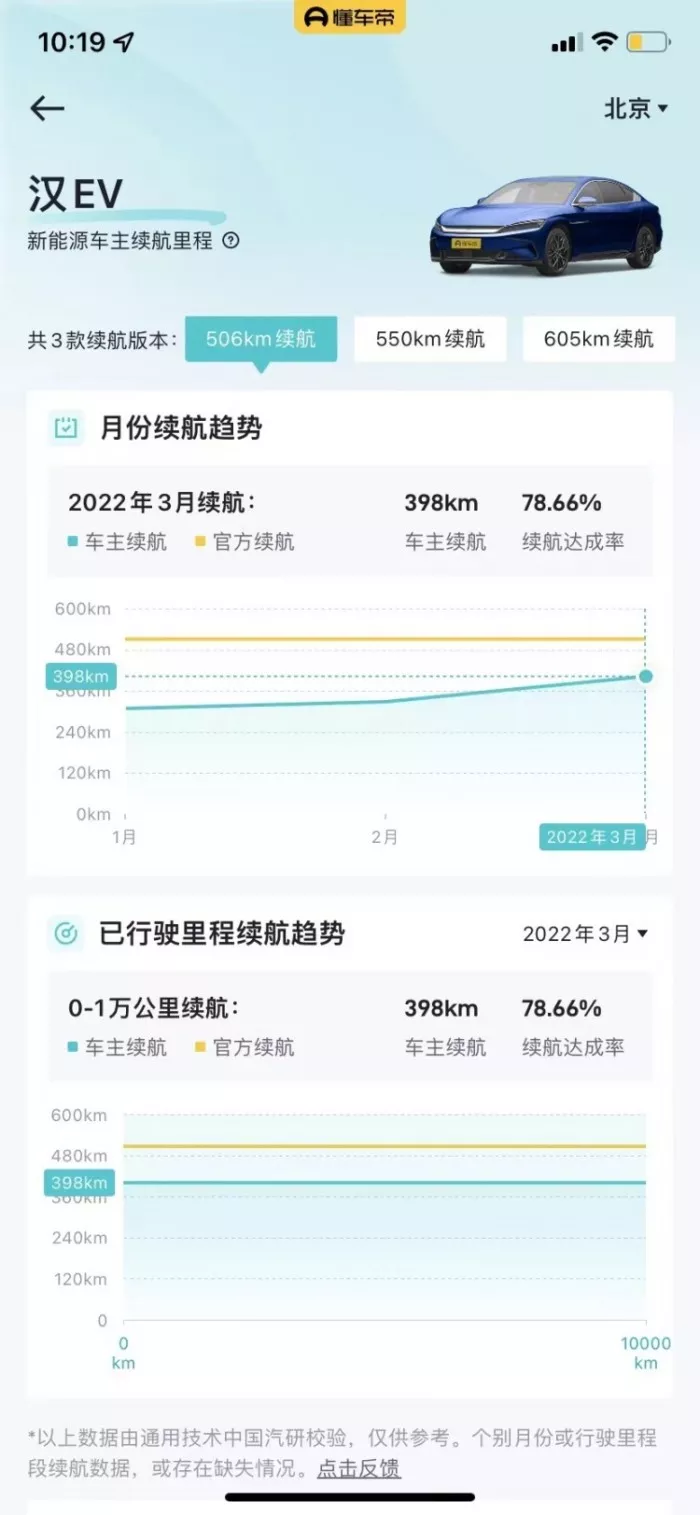
Understand the owner's endurance data of BYD Han EV on chedi app source: understand chedi app
Car owners can also check the practical information of charging time interval according to their average daily driving mileage. In addition, the endurance achievement rate of other models at the same level is used as a reference.
These real endurance data, for potential electric vehicle users, can be combined with their daily use demand scenarios to select vehicles more intuitively, rather than confused in various endurance standards.
For example, car owners in the north without charging piles can choose models with higher real endurance. Car owners who are not far away from their daily commute don't have to panic too much about the endurance of A00 and A0.
Over the years, in addition to the improvement of battery technology, main engine manufacturers are also committed to alleviating endurance anxiety in various ways.
For example, the power exchange network arranged by Weilai, the ideal exploration of 400V overcharge technology, the increasingly dense charging network, and the continuous promotion of technology and charging infrastructure environment will make people more and more tolerant of battery life.
In fact, after seeing the "true face" of electric vehicles, the so-called anxiety will be reduced.